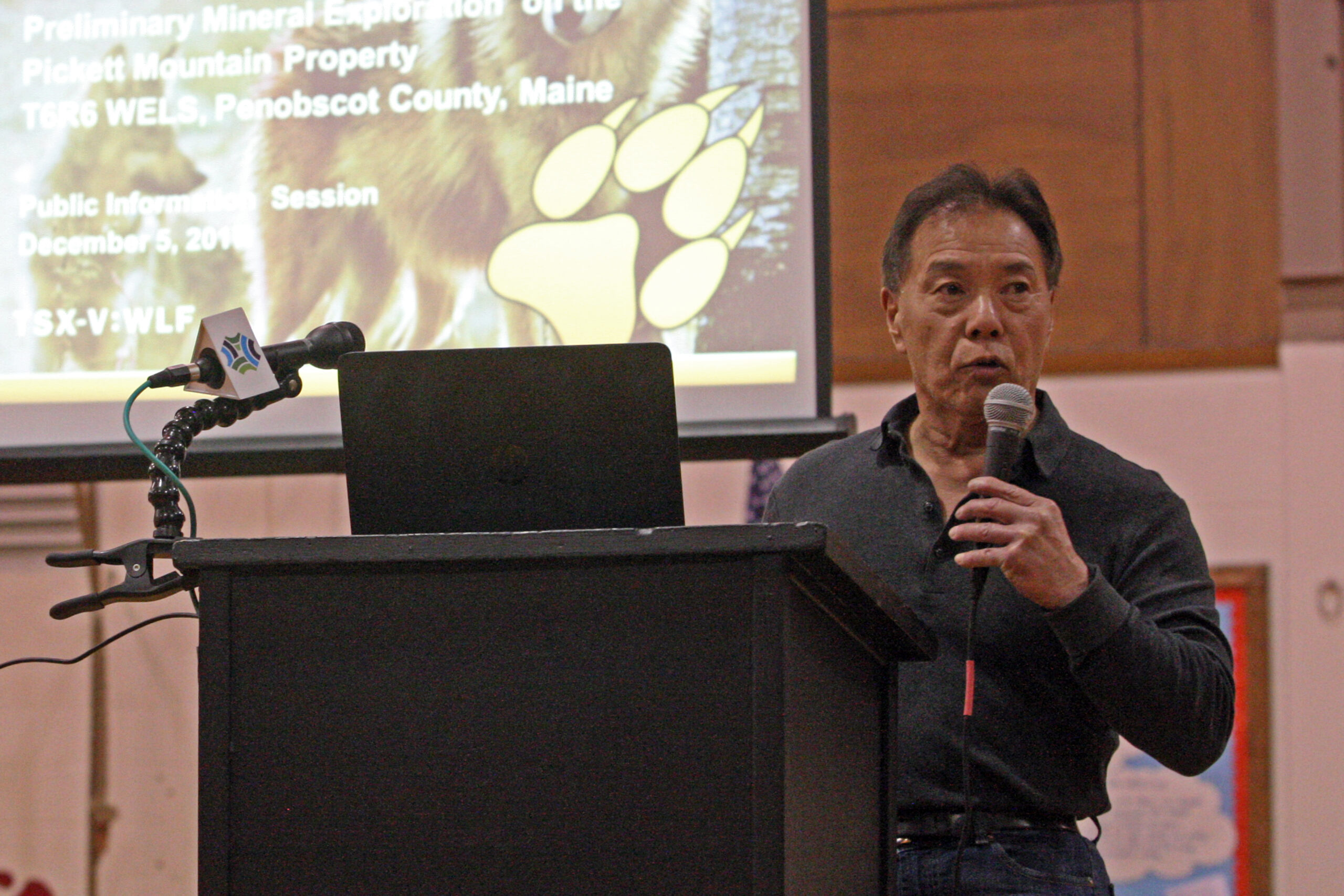
STACYVILLE, Maine — A Canadian mineral exploration company unveiled its initial plans Tuesday evening for analyzing a 6,871 acre parcel of land just north of Patten in the hopes of one day establishing a mine in the area.
“In our opinion, we think the state (of Maine) is very prospective for mineral deposits,” Donald Hoy, president and CEO of Wolfden Resources Corp., which bought the property in November, told the nearly 100 people attending a public presentation and question session at Katahdin Elementary School. “We see this (Pickett Mountain) as a very good opportunity. It is small, but in our opinion (Pickett Mountain) is one of the highest grade deposits in terms of silver, lead, zinc and copper.”

Location of major mineral deposits in Maine. (Courtesy/Maine Office of Geological Information Systems)
Among those in attendance were environmental activists, two state representatives — Mike Carpenter of Houlton and Chris Johansen of Monticello — and Raymond Foss, town manager of Patten and municipal administrator for neighboring Moro and Hersey.
“The site is adjacent to Moro and is accessed through Hersey,” Foss said. “And Patten is the biggest town in the area, so we will all be affected if this is a success. We all need industry in this region, but there are concerns about the environment.”
In his presentation, Hoy stated that an initial diamond drilling program would begin on Pickett Mountain in mid-December. The drilling is being done to first confirm the presence of precious metals and to also test for possible expansion from the property that the Thunder Bay, Ontario-based Wolfden Resources bought in northern Penobscot County for $8.5 million.
Hoy said Pickett Mountain represents one of the highest-grade undeveloped massive sulphide deposits in North America. He said excellent potential exists to enlarge the known deposit and to discover additional satellite deposits on the property and elsewhere in the outlying region.
The initial exploration involves drilling holes about 2.25 inches in diameter at depths from 150 to 2,000 feet. The company plans to do two test holes before the Christmas break. The firm plans additional drilling after the holidays.
The contractor for the drilling projects, Downing Drilling of Quebec, is in the process of getting registered to do business in the state of Maine, Hoy said.
He said it was impossible to say exactly how many holes would be drilled, but estimated that at least 25-30 would be dug at varying depths in the first phase. The core samples, which he said would look like ordinary rocks, will be loaded into dump trucks and likely sent to New Brunswick for analysis. He did not have an exact answer for how long that analysis process would take.

State Representative Mike Carpenter of Houlton poses a question at Tuesday’s informational meeting in Stacyville concerning potential mining at Pickett Mountain. (Joseph Cyr)
During the test drilling phase, Hoy stated that all steps would be taken to avoid any contamination of the environment and no blasting would take place during this portion of the project. Should a test hole hit water, it would immediately be capped.
A high-resolution, airborne geophysical survey, using a helicopter, will be completed over the Pickett Mountain area in January 2018 to determine a “geophysical signature” for the deposit and to look for prospective targets elsewhere within the belt hosting the Pickett Mountain deposit.
An initial program of environmental baseline study also will be completed in and around the Pickett Mountain deposit and elsewhere on the property in the spring of 2018. This study is viewed as a proactive measure, in the event that the site progresses to advanced exploration or a potential mining operation, he said.
If successful, Hoy said his company’s vision is to create a small underground operation with no negative impact to the local population or environment. Wolfden does not currently operate a mining facility and Hoy was unclear when asked whether his firm would develop such a mine at the site or sell the rights to another firm.
Hoy said that two or three local residents will be hired in this initial phase of exploration, but that it is possible as many as 100 individuals could be employed over a 10-year period, should a mining operation start up. But because they are only in the exploration stage, which can take as long as two or three years, an exact estimate was not possible.
“It is a long road from early-stage exploration to a mine,” he said.
Rep. Johansen of Monticello asked if the project would have any negative impact on recreation in the area, such as snowmobiling and ATV riding. Hoy replied he did not think the project would have any effect on recreational activities.
Bob Marvinney of the Maine Department of Agriculture’s Conservation and Forestry division and the director of the Maine Geological Survey told Hoy and others in attendance Tuesday that state agencies were “very aware” of the project.
- Nearly 100 people attended an informational meeting Tuesday evening at Katahdin Elementary School in Stacyville concerning mineral exploration at Pickett Mountain. (Joseph Cyr)
“All of the agencies are following this project very closely,” he said. “Enforcement of rules, for the early stages of exploration, would be carried out by the Land Use Planning Commission. Should this proceed to more advanced work, that would be the responsibility of the Maine Department of Environmental Protection.”

Patten Town Manager Raymond Foss speaks to the audience during Tuesday’s informational meeting on the Wolfden Resources Corp. mineral exploration on Pickett Mountain. Patten is the largest nearby town that could benefit economically from any mining operation that might result. (Joseph Cyr)
Maine has not had any large-scale metal mines operating since the 1970s, although several companies have explored areas around Bald Mountain and Pickett Mountain in the late 1970s and early 1980s.
The mining law enacted by the Legislature in June, LD 820, amended a controversial 2012 mining law with a host of provisions sought by environmental advocates, including banning open pit mining and large wastewater impoundments and strictly limiting discharges to groundwater. The law also established requirements for mining companies to post financial assurances covering the cost of a catastrophic mine failure for at least 100 years.
Star Herald Staff Writer Anthony Brino contributed to this article.








